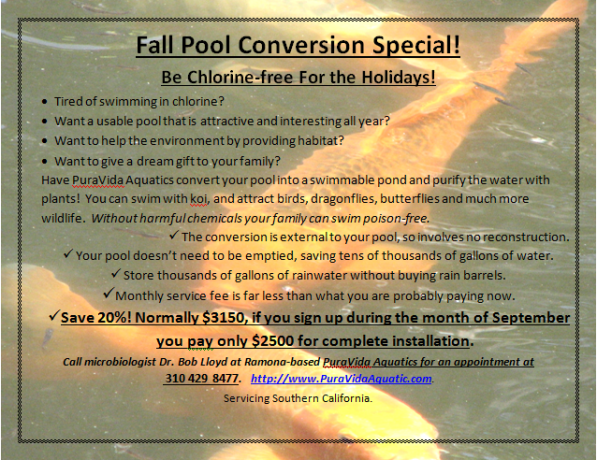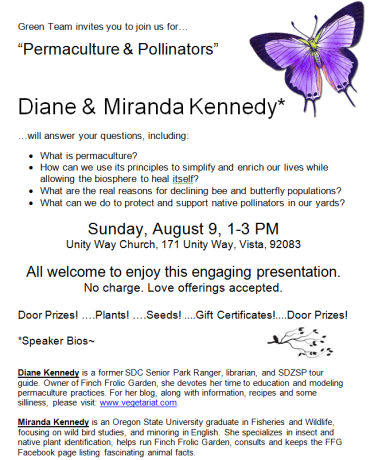- Animals, Bees, Birding, Compost, Fungus and Mushrooms, Gardening adventures, Heirloom Plants, Hugelkultur, Living structures, Natives, Other Insects, Perennial vegetables, Permaculture and Edible Forest Gardening Adventures, Photos, Ponds, Rain Catching, Recycling and Repurposing, Reptiles and Amphibians, Seeds, Soil, Water, Water Saving, Worms
October Garden
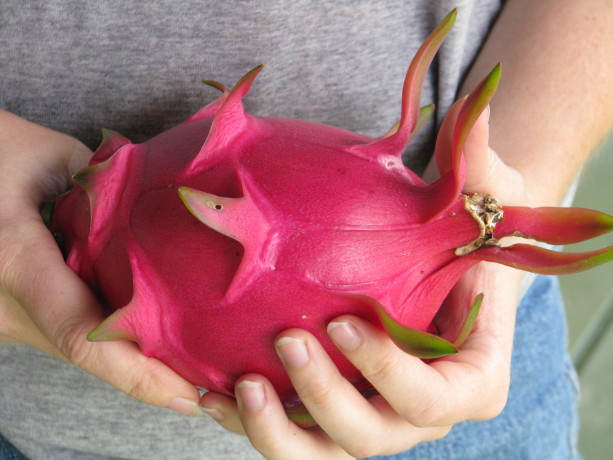
A huge dragonfruit; this kind is white inside. October is one of my favorite months, even when we’re on fire here in Southern California. This year we’ve been saved, and October is moderate in temperature and lovely.
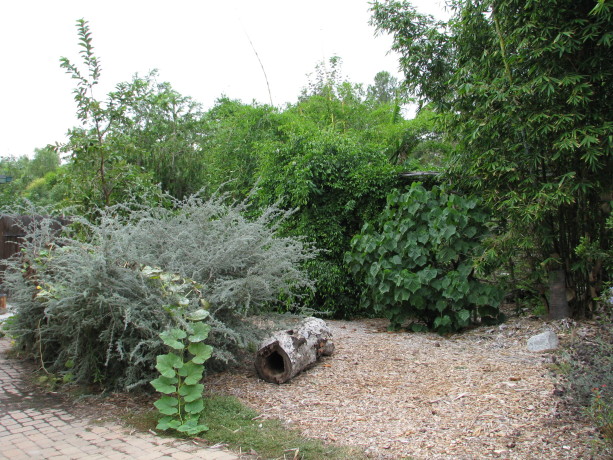
A volunteer kabocha squash vining its way through a bush. 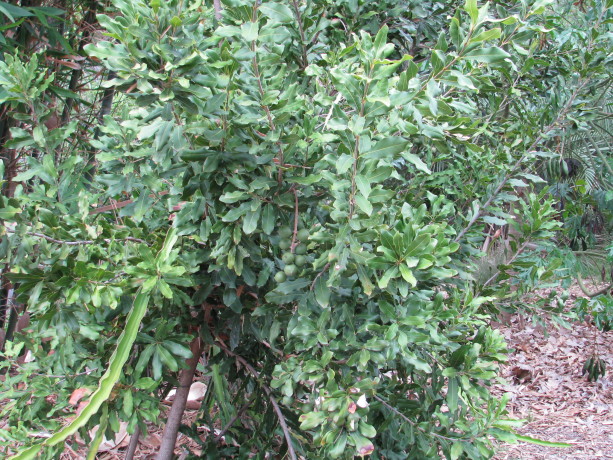
Our first ripeing macadamia harvest from a 3 year old tree, with a dragonfriuit snaking through. 
Edible hibiscus, volunteer nasturtiums and pathway across the rain catchment basin. 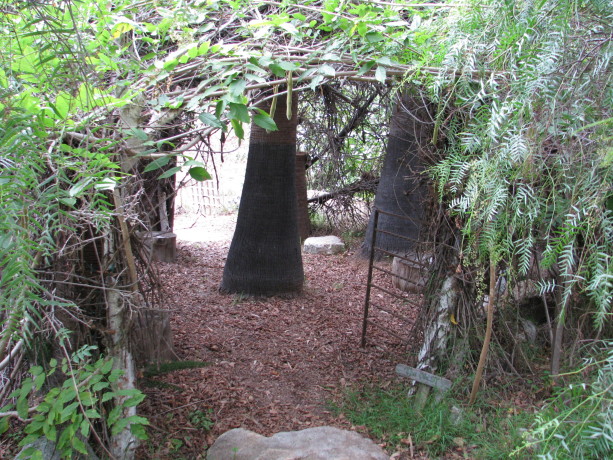
Into the wisteria-covered Nest. Summer has lost her vicious grip and we have time until the holiday rush and winter cold. Finch Frolic Garden has withstood the heat, the dry, the inundations, the snow and the changes, all without chemicals or much human intervention.
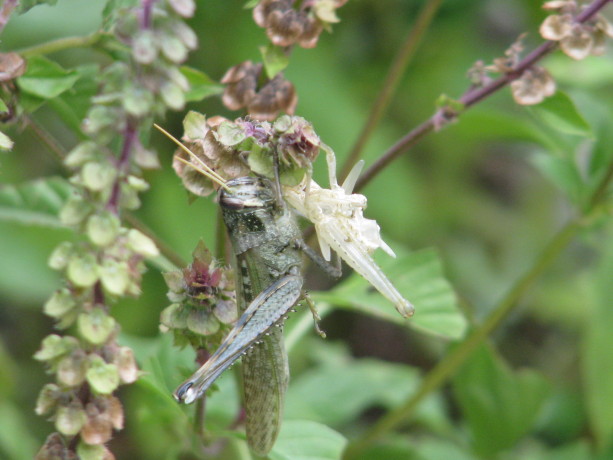
Grasshopper freshly out of last instar. 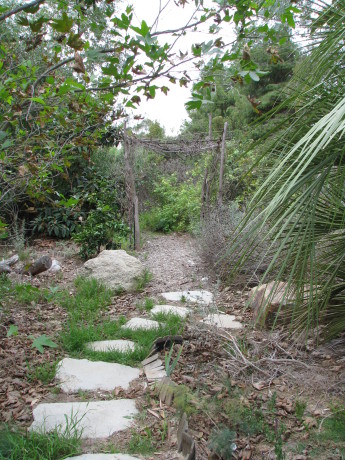
The curly willow trellis. We’ve lost some trees and shrubs this year, but that is mostly due to the faulty irrigation system which delivers too much or too little, and is out of sight underground.
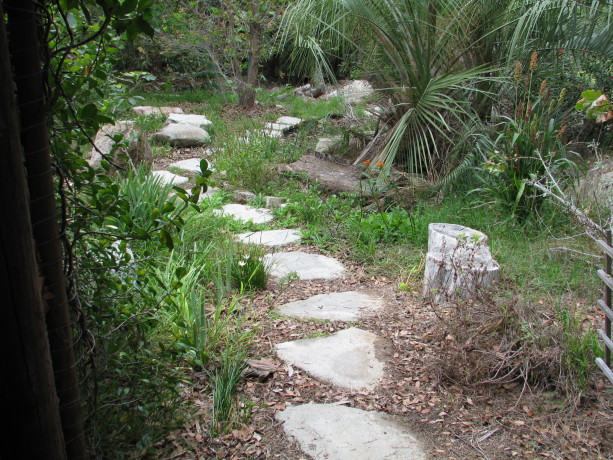
Urbanite pathway. 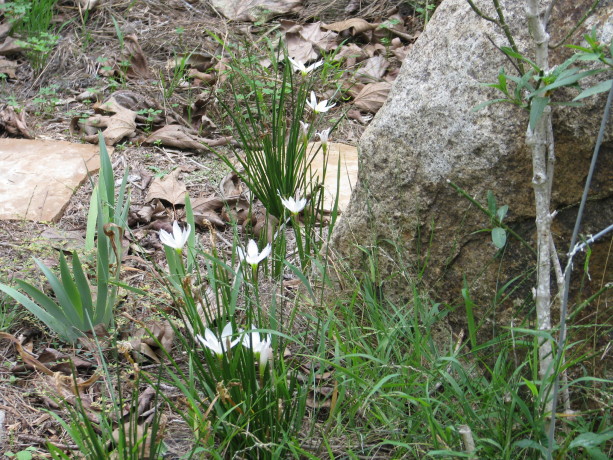
Bulbs will pop up year round for wonderful surprises. Permaculture methods in sheet mulching, plant guilds, swales, rain catchment basins, and the use of canopy have pulled this garden through.
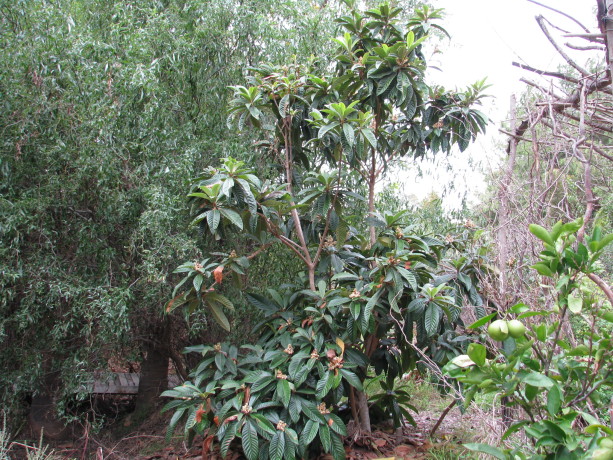
Loquat in bloom. 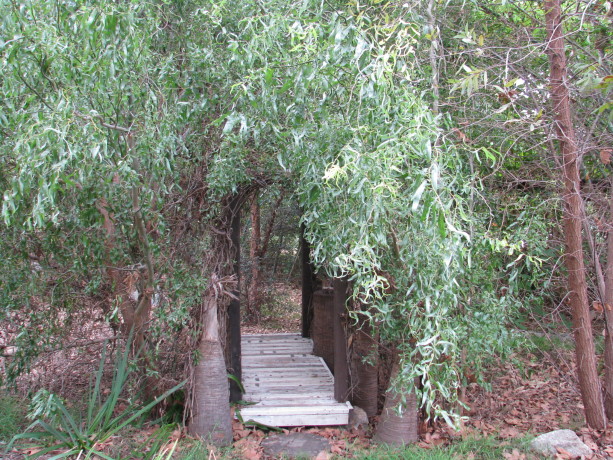
Bridge over currently dry streambed. 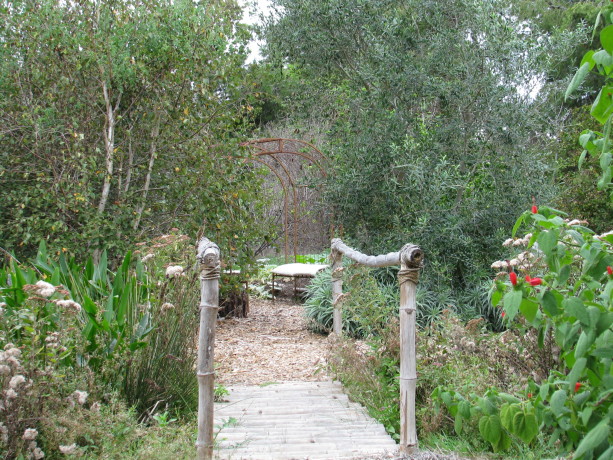
Bamboo bridge. 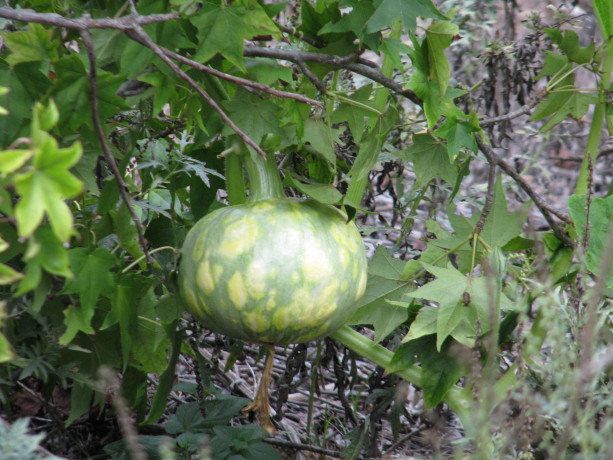
A gourd in a liquidamber. The birds, butterflies and other insects and reptiles are out in full force enjoying a safety zone. A few days ago on an overcast morning, Miranda identified birds that were around us: nuthatches, crows, song sparrows, a Lincoln sparrow, spotted towhees, California towhees, a kingfisher, a pair of mallards, a raven, white crowned sparrows, a thrush, lesser goldfinches, house finches, waxwings, robin, scrub jays, mockingbird, house wren, yellow rumped warbler, ruby crowned kinglet, and more that I can’t remember or didn’t see.
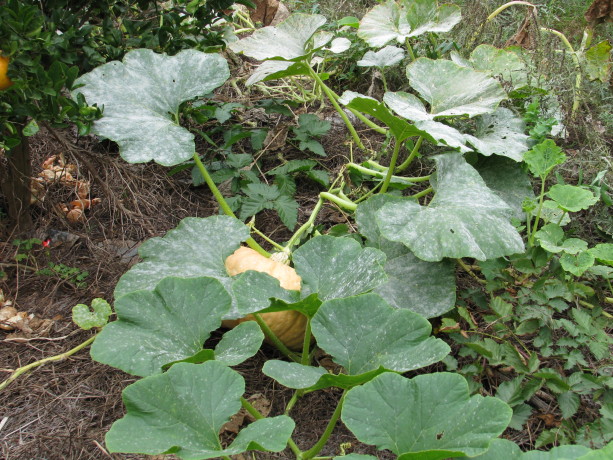
Squash! 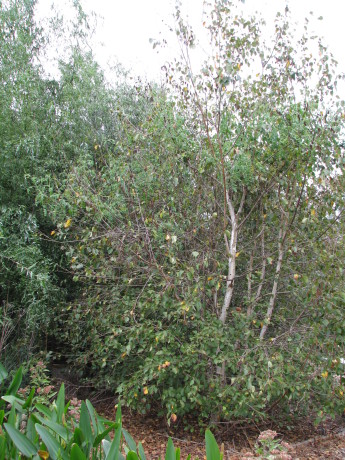
This birch has strange red fruit in its top boughs… 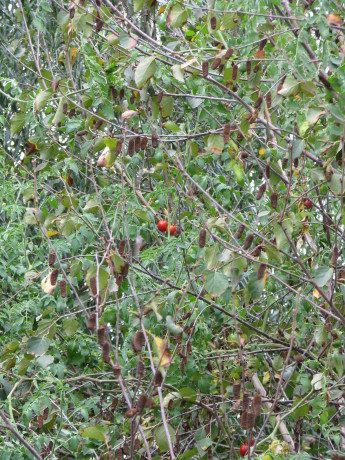
…a volunteer cherry tomato that is fruiting inconveniently ten feet up. Birds have identified our property as a migratory safe zone. No poisons, no traps. Clean chemical-free pond water to drink. Safety.

Squash and gourds happily growing out of the hugelkultur mound. 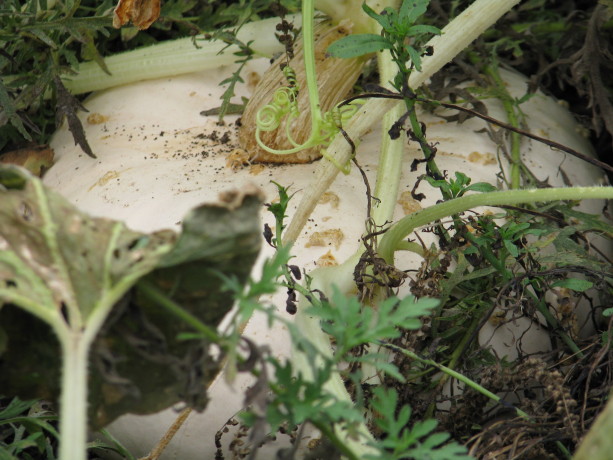
A surprise pumpkin hiding in the foliage. 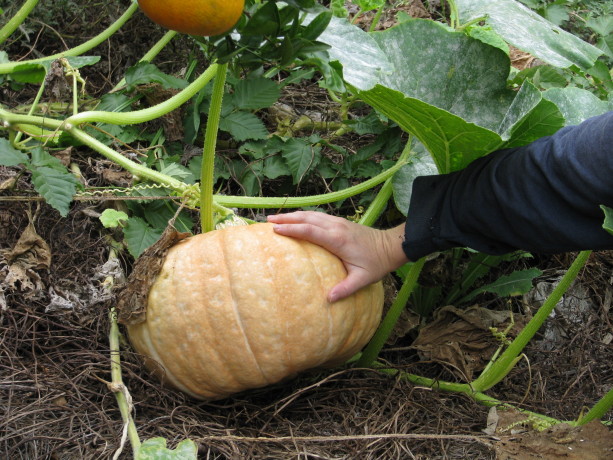
A huge and lovely gourd. 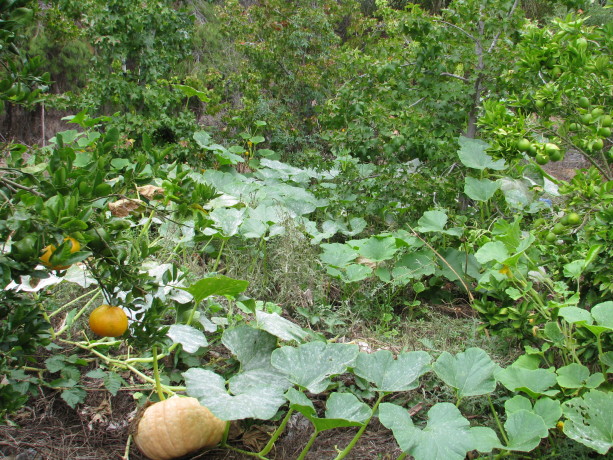
Vines taking advantage of vertical spaces by going up the trees. You can provide this, too, even in just a portion of your property. The permaculture Zone 5.
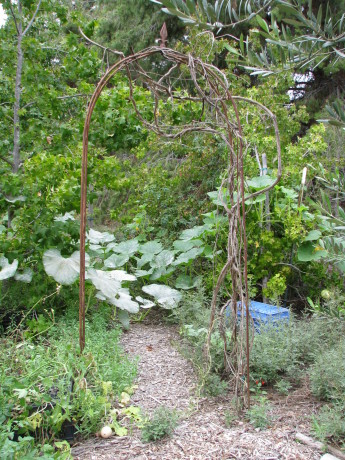
Why did the gourd cross the road? To climb up a liquidamber, apparently. 
A glimpse of pond through the withy hide 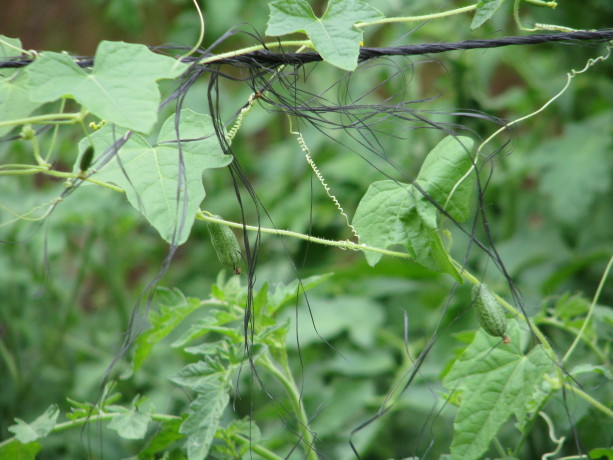
Mouse melons on a tiny vine. More cucumber than melon, they grow to be olive-sized. 
Time for me to get in the water and trim back the waterlilies before the water temperature drops! 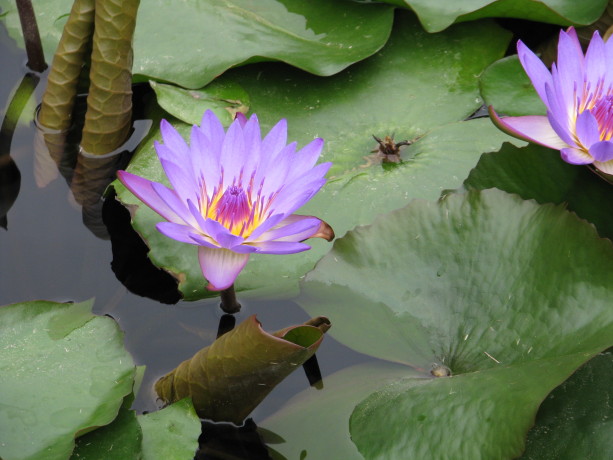
Purple water lilies in the pond. I’m indulging in showing you photos from that overcast October morning, and I hope that you enjoy them.

Eden rose never fails. 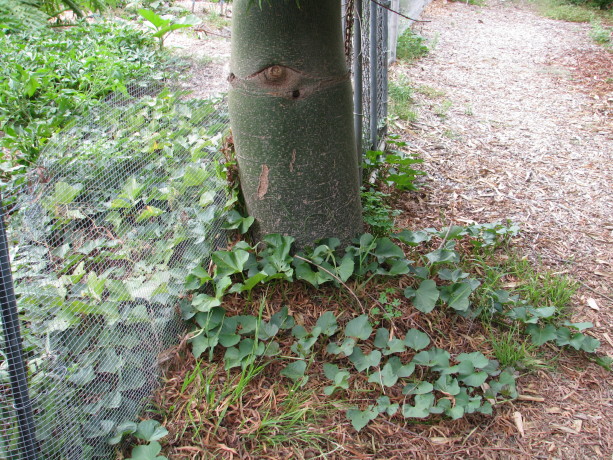
Sweet potato vines escaping the veggie garden; the leaves are edible. 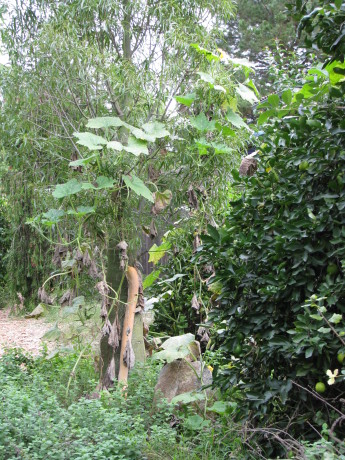
See the long tan thing on the trunk? That’s a zucchino rampicante, an Italian zucchini. Eat it green, or leave it to become a huge winter squash. 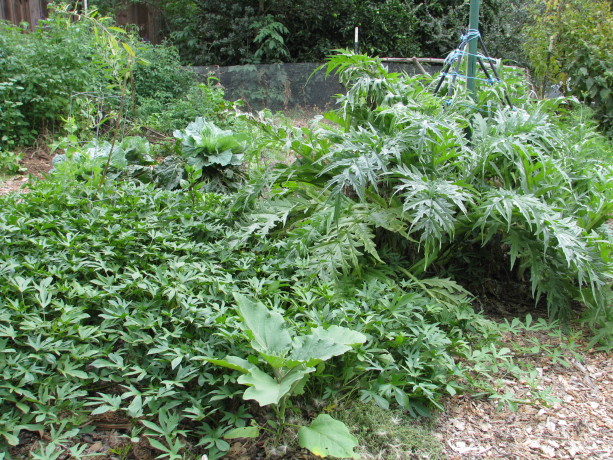
Violetta artichokes regrowing in our veggie garden, with a late eggplant coming up through sweet potato vines. - Animals, Bees, Birding, Compost, Gardening adventures, Health, Microbes and Fungi, Natives, Other Insects, Pets, Ponds, Predators, Quail, Rain Catching, Reptiles and Amphibians, Soil, Water, Water Saving, Worms
Why Buy Rain Barrels if you Own a Pool? Pool Conversion Discount!
Why buy rain barrels if you own a pool? You can collect about 20,000 gallons of rainwater in an average pool, and use it on your landscaping and for swimming if you don’t chlorinate it. If you have a pool or pond and put chemicals into it, or have a saltwater pool or one that is treated with UV light, you really need to read about how toxic those systems really are and how to change your pool into a swimmable, clean pond on PuraVidaAquatic.com. On that site is a host of great information about how bad mosquito fish are, how to make a truly healthy pond, why having a pond in a drought is a great idea and so very important, and so much more. If you live in Southern California and have a pool, you’ll be interested in this Fall Special:
- Animals, Bees, Birding, Compost, Fungus and Mushrooms, Gardening adventures, Health, Heirloom Plants, Microbes and Fungi, Natives, Other Insects, Perennial vegetables, Permaculture and Edible Forest Gardening Adventures, Pets, Ponds, Predators, Quail, Reptiles and Amphibians, Water, Water Saving, Worms
Permaculture and Pollinators lecture
- Animals, Bees, Birding, Building and Landscaping, Gardening adventures, Health, Microbes and Fungi, Natives, Other Insects, Permaculture and Edible Forest Gardening Adventures, Pets, Ponds, Predators, Quail, Rain Catching, Recycling and Repurposing, Reptiles and Amphibians, Water, Water Saving, Worms
Turn Your Pool Into a Pond, and Help Restore Wetlands!
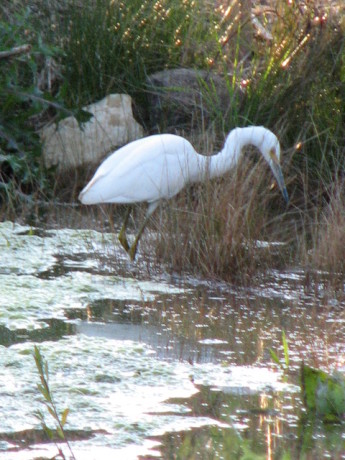
An egret on the hunt. Water birds now rely on flooded agricultural fields, which are saturated with herbicides and pesticides. It is estimated that 97% of California’s wetlands are gone. Gone. About two-thirds of that remaining 3% is dysfunctional and polluted. In Los Angeles, only 1% of wetlands remain. We have constructed our properties to drain precious rainwater and even irrigation water into culverts and out to the ocean, rather than collect it in our soil where it belongs. All the riparian animals, from specialized aquatic microbes and fungi up to large mammals, have gradually all but disappeared. What we have instead of wetlands are millions of chlorinated swimming pools, lined ponds and bird baths. Although we may believe that these help animals, the treated water is weakening and killing them with chemicals when they are desperate enough to drink from them, and offer no shelter or food source.
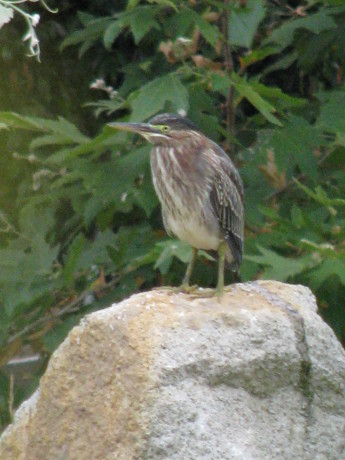
A young green heron. Dr. Bob Lloyd of Pura Vida Aquatics, a Southern California-based business, has spent the last 20 years maintaining ponds chemical-free. “Algicide will kill aquatic microbes, and hurt hummingbirds and all the other creatures that drink it,” he says. To help offset some of the loss of wetlands Dr. Lloyd converts swimming pools into swimming ponds that are cleaned with plants and fish rather than with chemicals.
You may see photos of some methods of pool conversions on the Internet that look fantastic, but really are expensive and drastic, and hard to maintain. They require the draining (and waste) of the 22,000 gallons (more or less) of pool water, the altering of the pool itself by building a cement planting bed along the inside and the filling of that bed with a large amount of gravel. Plants are set in the gravel and after refilling a pump sends water through this system to clean it. The gravel would need to be cleaned over time, which would mean draining water again and hauling out a ton of slimy gravel, and buying new.
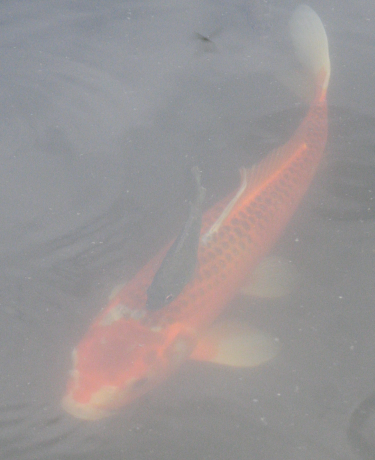
Bluegill and koi buddies. Dr. Lloyd’s system is far less expensive, not invasive to the pool structure at all and is easily removable if years down the road the system is no longer desired. His system is unique and is the product of his PhD in microbiology and his decades of experience working with natural ponds. The plants that are installed are outside of the pool and can have a look that goes with the surrounding vegetation. Even aquatic edibles can be experimented with, such as watercress, water chestnuts and more.
Installing plants inside a pool can be done without changing the pool structure if the pool isn’t going to be used for swimming, or only for gentle laps. The reason is that the splashing water and waves from vigorous swimming is very hard on plants. Many plants die from having too much water on their leaves, and from being battered against the sides of the pool. Using Dr. Lloyd’s method of external decorative plants the pool has the ambiance of a pond and the usability of a regular swimming pool. And you can still swim with koi and other fish! How cool is that?
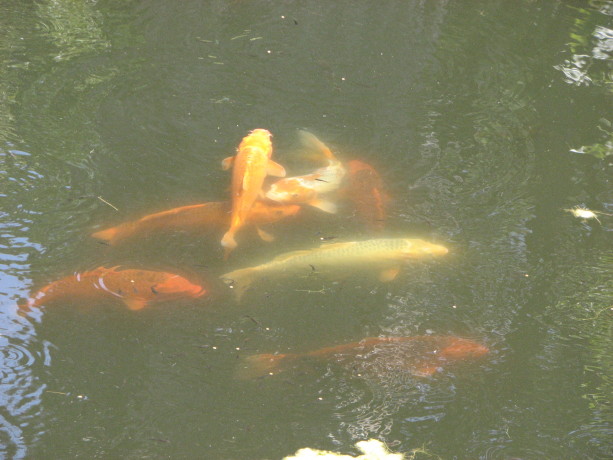 Converting your pool or pond takes a little patience as the biology develops; do you remember the adage that you can’t rush Mother Nature? The evolution of a pool conversion lasts several months. Watching the evolution of a chemical pool to a swimming pond is exciting. With the absence of chlorine, there is a natural algae bloom which turns the inside of the pool a bright, beautiful green. The algae help clear the water of harmful chemicals. As the water is routed through plants, some of the aquatic creatures that balance a pond are added from a local source. As the water clears, fish are added. The fish eat the algae so there are no fuzzy green threads growing up from the bottom or floating on the surface. Fish can be added within weeks of the start of the project. “Its like managing a 20,000 gallon fishtank,” Dr. Lloyd grins.
Converting your pool or pond takes a little patience as the biology develops; do you remember the adage that you can’t rush Mother Nature? The evolution of a pool conversion lasts several months. Watching the evolution of a chemical pool to a swimming pond is exciting. With the absence of chlorine, there is a natural algae bloom which turns the inside of the pool a bright, beautiful green. The algae help clear the water of harmful chemicals. As the water is routed through plants, some of the aquatic creatures that balance a pond are added from a local source. As the water clears, fish are added. The fish eat the algae so there are no fuzzy green threads growing up from the bottom or floating on the surface. Fish can be added within weeks of the start of the project. “Its like managing a 20,000 gallon fishtank,” Dr. Lloyd grins.Immediately the changes to the environment are apparent. Dragonflies, butterflies, hummingbirds and many more creatures desperate for truly clean (chemical-free) water are attracted to the water and the plants.

A hummingbird coming in for a drink in one of Dr. Lloyd’s newly chemical-free ponds. “I have clients who tell me how excited they are to see so many birds, insects and lizards in their yards that they’d never seen before,” Dr. Lloyd relates about his converted ponds. “Finding (native) Pacific chorus frogs around the ponds has been very fun.” Some of his clients have become active bird watchers as the wildlife come to ponds that he manages.
Best of all, you can swim with the fish and have no red eyes, green hair or other bad reactions to the harsh chemicals. The plants phytoremediate the water as it is pumped through the planting beds. Children can dangle their feet in the pond without fear of absorbing algicide and other harsh chemicals through their skin.
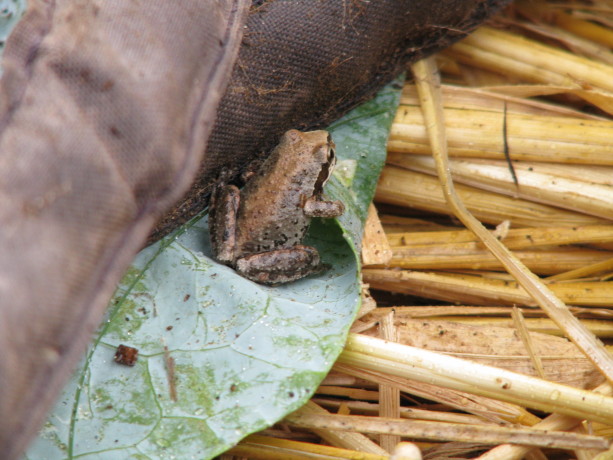
Pacific Chorus frogs are native and disappearing. They live in your garden during the year and eat insects. Because we are in a drought, people believe that drying out their pond or pool is necessary. No! Pools evaporate far less water than irrigated lawns and landscapes. What does evaporate helps hold humidity around your plants, something which our drying climate is eliminating. Humidity keeps pollen viable and helps trees and plants survive the lack of rainfall. If you convert your pool and/or pond to a chemical-free one, then it is now supplying habitat to creatures further taxed by dried-up water supplies. What’s more, your pool which isn’t attractive and is rarely used, which must be doctored with chemicals weekly, can be converted into something that benefits wildlife year-round, is interesting to watch all the time, and needs absolutely no chemicals.
Pools are also excellent catchment basins for rain. Instead of buying a large water tank, divert your roof water to your pool and allow the plants to clean it. Then you can use that water at any time during the year for watering plants – with chlorine- and chloramine-free water. In permaculture, everything should have at least three purposes. By converting your pool you can have a free rain-catchment system, a water cleaning system, a safe recreation area, a pleasing view, and some habitat, all while saving money and reducing your carbon footprint and reducing your water bill. How can you not do it?
A converted pool does require weekly maintenance, but not the usual kind with chemicals and cleaners. I remember having to clean the family’s pool when I was growing up and testing the pH, even though we didn’t swim very often. It wasn’t fun. The maintenance on a chemical-free pond consists of checking on the pump, the caring for the plants and fish, and insuring that the clarity of the water and the product is satisfying to the customer. The ecosystem evolves and must be watched. It also costs a fraction of what a pool cleaner charges.
If you have a pond or pool that is on a chemical system, consider a conversion. You’ll spend far less money, have far more entertainment, decorative and educational value, have safe water for your family and wildlife to enjoy, will be helping the environment by not supporting harmful chemicals and by helping off-set the millions of acres of wetlands that are gone.
Dr. Lloyd estimates that he’ll need to convert 1.6 billion swimming pools to offset all the wetlands that have been drained and paved over in California alone. How can it be done?
“One pool at a time,” he smiles.
You can find out about pool and pond conversions by contacting Dr. Bob Lloyd at Pura Vida Aquatics, 310- 429- 8477 http://www.PuraVidaAquatic.com. He has accounts from San Diego through Los Angeles, and can consult elsewhere.
- Animals, Bees, Birding, Compost, Fungus and Mushrooms, Gardening adventures, Health, Heirloom Plants, Houses, Hugelkultur, Microbes and Fungi, Natives, Other Insects, Perennial vegetables, Permaculture and Edible Forest Gardening Adventures, Ponds, Predators, Quail, Rain Catching, Recycling and Repurposing, Reptiles and Amphibians, Soil, Vegetables, Water, Water Saving, Worms
My Plea Against Gravel
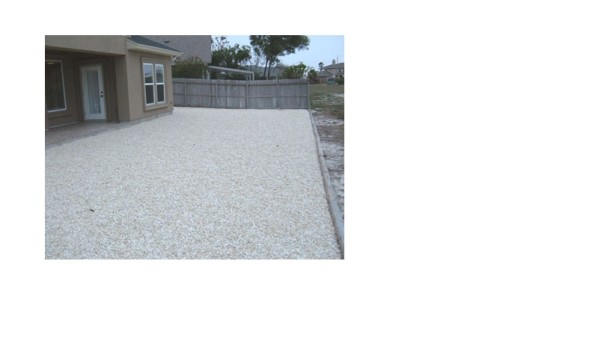 Here in Southern California, as in many other areas, we are finally legally recognizing the drought. There are rebates in place for those who take out their lawns, and here in Fallbrook there is a 36% water reduction goal. Many people just don’t know what to do with all that lawn. A very unfortunate continuing trend is to dump half a ton of colored gravel on it. Please! NO! First of all, once down gravel is nearly impossible to get out again. Gravel, like all rocks, is thermal mass. Instead of having a large rock heating up and radiating out heat, with gravel there are tens of thousands of surfaces radiating out heat and reflecting light and heat back up. It is the worst kind of hardscape. All that reflected heat and light heats up your home, making you use your air conditioner more frequently which is a waste of energy, and also dries out the air around your home. Desertification reflects light and heat to a point where moist air moving over a region dries up. There is less rain, or no rain. Most trees and plants trap humidity under their leaves. Gravel reflects light and heat back up under those leaves and dries them out, sickening your plants and trees. Pollen travels farther on humid air; it can dry out quickly. If you are relying on pollination for good fruit set between trees that are spaced far apart, then having some humidity will increase your chances of success.
Here in Southern California, as in many other areas, we are finally legally recognizing the drought. There are rebates in place for those who take out their lawns, and here in Fallbrook there is a 36% water reduction goal. Many people just don’t know what to do with all that lawn. A very unfortunate continuing trend is to dump half a ton of colored gravel on it. Please! NO! First of all, once down gravel is nearly impossible to get out again. Gravel, like all rocks, is thermal mass. Instead of having a large rock heating up and radiating out heat, with gravel there are tens of thousands of surfaces radiating out heat and reflecting light and heat back up. It is the worst kind of hardscape. All that reflected heat and light heats up your home, making you use your air conditioner more frequently which is a waste of energy, and also dries out the air around your home. Desertification reflects light and heat to a point where moist air moving over a region dries up. There is less rain, or no rain. Most trees and plants trap humidity under their leaves. Gravel reflects light and heat back up under those leaves and dries them out, sickening your plants and trees. Pollen travels farther on humid air; it can dry out quickly. If you are relying on pollination for good fruit set between trees that are spaced far apart, then having some humidity will increase your chances of success.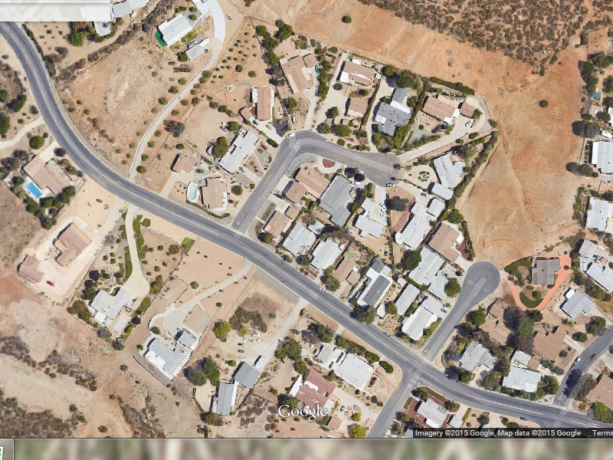
An area of Wildomar, surrounded by hillsides of chaparral that hasn’t been destroyed. These homes have mostly gravel yards and denuded, compacted backyards. Very little rain penetrates, and all the weeds that nature sends it to help repair this gash in the earth are promptly poisoned. This is death to us and our planet. By laying gravel you are turning soil into rock-hard dirt, because microbial life cannot live closely under it. That robs any plants you have stuck into the gravel of the food they need from the soil, which is opened up through microbial activity. You are adding to the heat value of the hardscape around your house causing you to cook in the summer and use more air conditioning. You have reduced habitat to zero. You have added to global warming by reflecting more heat and light into the sky. Although gravel is permeable, usually the ground below it bakes so hard that rain doesn’t percolate. I’ve read sites that want to you increase the albedo effect by laying gravel. In the short term albedo helps cool the atmosphere, but as a result of too much reflected light dries everything out. Think of the dark coolness and dampness of forests… that are now bare ground.
What do you do with your lawn instead? There are many choices that are so much better for the earth and your quality of life. First step, cut swales on contour on any slopes for best rain harvesting. Flat lawn? Easier still. Turn your lawn into a beautifully landscaped lush native garden. I’m not talking about a cactus here and there, but a creation with the awesome native plants we have in Southern California. Some of them such as Fremontia can die with supplemental summer water!

A beautiful border and plantings of California natives. Very low water use here, and very high habitat! There is a chocolate daisy that smells like chocolate. Oh yes. And how can you not want to plant something called Fairy Duster or Blue-Eyed Grass? A native landscape planted on soil that has been contoured to best catch and hold water, and amended with buried wet wood (hugelkultur), will give much-needed food, water and breeding grounds to countless birds, butterflies, native insects and honeybees.
Or put in a pond. Wait, a pond during a drought? Yes! Ninety-nine percent of California wetlands have been paved over, drained or are unusable. Where are all the animals drinking? Oh, wait, we are in the epicenter of extinction, mostly due to wetlands loss. There are very few animals left that need to drink. Those that are left have to take advantage of chlorinated water in bird baths and swimming pools. The microbially rich and diverse clean, natural water that fed and sustained life is just about gone. So what can you do? If you have a swimming pool, you can convert it either entirely to a pond, or into a natural swimming pool that is cleaned by plants.
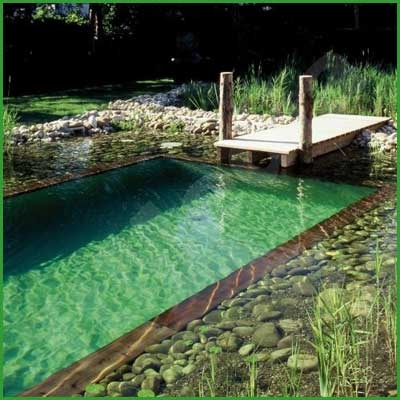
A natural pool upgrades your pool to a lovely pond without the use of chemicals. Suddenly instead of having this expensive eyesore that you use only a couple of months a year and pour chemicals into year-round, you have a lovely habitat that you want to sit and watch, and even better, swim in safely without turning your hair green or peeling your skin. You don’t need to clean the pool all the time, and you don’t need to put in chemicals. If you are in the San Diego or Los Angeles area, call Dr. Robert Lloyd of PuraVida Aquatics for a consultation and conversion. If you don’t have a pool, then build one that is cleaned by plants and fish. You don’t need a filtration or oxygenation system because the biology does it all. Where do you get the water from to top off your pond?
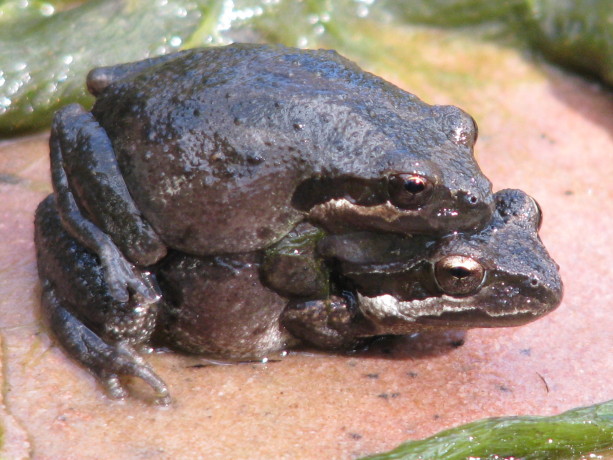
Native Pacific Chorus Frogs enjoying our clean pond at Finch Frolic Garden. Connect your pond to a lovely, planted stream that is connected to your laundry water or graywater system. You are buying water every day, so why not compost your water through phytoremediation and have a pond full of great healthy chemical-free water that is wonderful to look at and is an oasis for thirsty animals and insects?
Or install a food forest. With good soil building and rain catchment first, and planting in guilds with sheet mulch around trees and on pathways, you will be using a fraction of the water you pour on your lawn and yet harvest lots of food. Too much food? Share it with a food pantry!
Or start a veggie garden without digging any sod.

Create a lasagna garden right on top of the lawn and start growing immediately. Layer cardboard, sticks, grass, food scraps, leaves, more grass, more food scraps, more leaves and top it with about 8 inches of good soil, then plant right in it! That lovely standing compost heap will slowly turn into good soil while killing the grass beneath and growing crops for you immediately.
If ridding yourself of a lawn just breaks your heart, then substitute the high-water use grasses for a native grass mix that is comparable. Look at S&S Seeds for prices or for seed choices. Water a few times with Actively Aerated Compost Tea using any rainwater you may have caught in those 50-gallon containers and your grass roots will travel so deeply that they will find groundwater. Check up on the work of soil microbiologist Dr. Elaine Ingham and see how easy AACT is to make and use.
There are so many alternatives to using gravel that aren’t expensive, that are an investment in your property and in reclaiming habitat while beautifying your home and saving money. So please, just say, “NO,” to the gravel. Tell a friend!!
Which one of these would you rather live in? Which do you think is better for the earth and for the future generations?

Finch Frolic Garden, year 3. - Animals, Bees, Compost, Fungus and Mushrooms, Gardening adventures, Health, Hugelkultur, Microbes and Fungi, Natives, Other Insects, Perennial vegetables, Permaculture and Edible Forest Gardening Adventures, Ponds, Rain Catching, Recycling and Repurposing, Seeds, Soil, Water, Water Saving
Fun With Worms and Microbes!
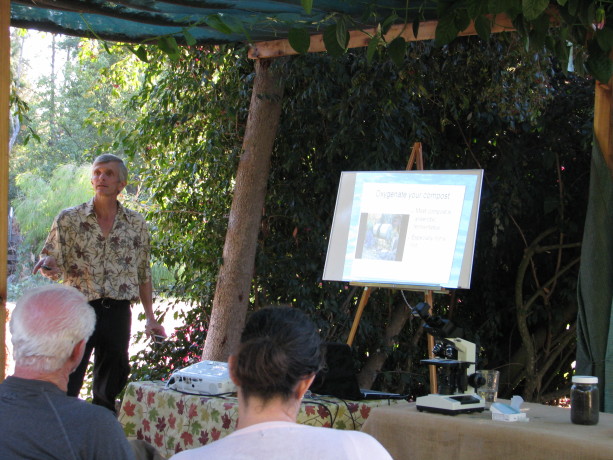
Enjoy a talk in the shade of Finch Frolic Garden with Doctor of Microbiology Bob Lloyd. Finch Frolic Garden’s Monthly Program in the Garden Series
Sunday, April 26, 2015, 2 – 4 pm.
Want to learn how to save water, and get the most out of the water you already buy?
How to improve your soil and how to grow food without chemicals…and why?
How to raise compost worms successfully?
DON’T MISS THIS CLASS!
Discover the world of the unseen! Sit in the shade at beautiful Finch Frolic Garden and enjoy a talk and demonstration with microbiologist and owner of PuraVida Aquatics Dr. Bob Lloyd (http://www.puravidaaquatic.com/). He’ll introduce you to the importance of soil microbes, water organisms, compost worms, and so much more! Using slides, videos, specimens and a microscope Dr. Lloyd will teach you a new way to look at healthy soil and water, and how to have both without chemicals. Each attendee will receive a sample either of compost worms or aquatic beneficials. We will, of course, offer homemade vegetarian refreshments. Cost is $25 per person, mailed ahead of time. Finch Frolic Garden is located at 390 Vista del Indio, Fallbrook. Please RSVP to dianeckennedy@prodigy.net . More information can be found at www.vegetariat.com. You’ll love what you learn!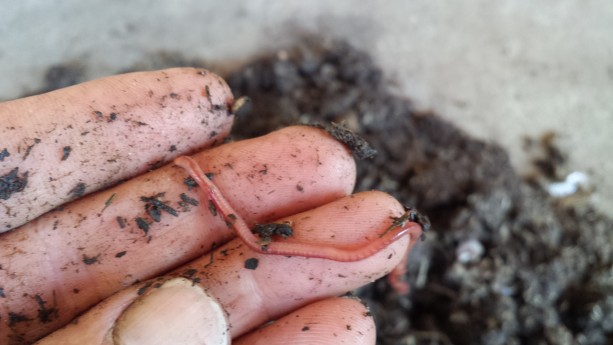
How to grow compost worms successfully! - Animals, Bees, Birding, Building and Landscaping, Chickens, Compost, Fungus and Mushrooms, Gardening adventures, Hugelkultur, Microbes and Fungi, Natives, Natural cleaners, Other Insects, Permaculture and Edible Forest Gardening Adventures, Pets, Ponds, Predators, Quail, Rain Catching, Reptiles and Amphibians, Water Saving, Worms
Saving the Bees

The ponds at Finch Frolic Garden are cleaned by fish and plants, with no chemicals, algaecide, artificial aeration or filtration. Well-balanced water allows wildlife to thrive. I should have more accurately called this post, Saving All the Insects, or even Saving the Wildlife, because the answer to saving one is the answer to saving them all. We’ve been inundated for years – my whole lifetime, in fact, – with pleas to save our environment, stop whale slaughter, stop polluting, etc. I remember winning a poster contest in fifth grade on the subject of curtailing littering. Since Rachel Carson’s books woke people up to the hazards of DDT and how chemicals have many deadly side effects there has been a grassroots effort to stop the pollution. Since Al Gore’s An Inconvenient Truth came out the push for environmentally friendly lights, cars, LEED-certified buildings and many more positive anti-climate-change actions have grown furiously. Too bad no one listened to him decades before. A drop in the economy and the radical change in weather patterns have people exploring organics, making their own clothes and foods, changing their shopping habits and thinking about what they are bringing into their homes. However, this week the World Wildlife Fund released the staggering results of a study that states that between the years 1970 and 2010, 52% of the world’s animal populations are gone. Over half. Gone. On our watch. In my lifetime. I am stunned with shame. So what about the next 40 years? Over 97% of California wetlands are already gone. There are only 3% left in Los Angeles. The Colorado River hasn’t met the ocean for decades, except briefly last year due to major earthworks. We are pumping all that water overland, open to the sun for evaporation, to treatment plants that fill it with chlorine and other chemicals, then sell it to us to spray over lawns and flush down the toilet or let run down the drain while the water heats up. It is madness. All the wildlife that depended upon the Colorado River along that stretch are gone. All the insects, the frogs, lizards, birds, mammals, etc. that need a clean drink of water no longer have access to it. The only water they can drink is usually chlorinated domestic water in ponds and bird baths. Too often this water is treated with algaecide, which claims it doesn’t hurt frogs but it does kill what the frogs feed upon. We are killing our animals with poisoned domestic water.
![dry_colorado_new[1]](http://www.vegetariat.com/wp-content/uploads/2014/10/dry_colorado_new1-613x321.jpg)
One of the largest reasons we have extinctions in North America is mismanagement of rainwater in drylands (other than polluting the waters. Poaching, over-fishing, destruction of habitat and climate change are the main reasons). We have cleared and flattened the ground, and channel rainwater off into the ocean. Look around at your streets and houses. Are they harvesting water or channeling it? Any property that is slanted is channeling water away. Any property that is level – like the bottom of swales – is harvesting water. So many properties are inundated with annual rains because there is no water harvesting above them. When you harvest water, it runs into rain catchment basins and swales instead of roaring down the hillside taking all the topsoil with it. Water becomes passive and percolates down deeply into the soil. That deep saturation draws tree roots down into the ground. The roots break up hardpan, make oxygen and nutrient channels into the dirt and produce exudates (sugars, carbohydrates and starches) through their roots to attract and feed the billions of microbes that turn your dirt into rain-holding soil. That underground plume of rainwater then slowly passes through your soil, re-enervating subterranean waterways, refilling your wells and bringing long-dry streambeds back to life. We must harvest rainwater to save our animals and plants, and consequently ourselves. We must reestablish sources of clean, unpolluted chemical-free water for animals to eat and from which to drink.
Healthy pond water is off-color due to tannins, and is filled with tiny creatures. Some such as daphnia are visible, but just like soil microbes, many aquatic creatures are microscopic. Fish and frogs feast from this level of the food chain, and these creatures make the water balanced. They eat mosquito eggs. They clean up algae. They are as vitally important as soil microbes. Oh, and 83% of the frogs are gone.
I spoke with Quentin Alexander from HiveSavers today; he performs humane bee rescue around the San Diego area and has been trying to re-queen Africanized hives with calmer European queens which will breed nicer behavior back into the bees rather than having to kill the entire hive. He has had no luck in the past two years with European queens, even those bred in California. With very little wetlands left, and those often sprayed with DEET by Vector Control, or polluted with chemical fertilizers and oils washed out of front yards, streets and driveways, these insects must resort to drinking from swimming pools and bird baths. Again, these contain highly chlorinated water. Animals are being forced to drink poison, or not drink at all.
We MUST stop using chemicals on our properties, and we MUST harvest rainwater. We MUST stop spraying well water into the air but irrigate with it in dripper form under mulch so that it is cycled back into the ground rather than evaporated. One inch of rain on one acre in one hour is 27,154 gallons of water! It is so easy to harvest rainwater – dig level-bottomed swales! Dig small ones with a trowel. Fire up the tractor and turn road ways into swales, or cross-cut vertical paths with swales that have dedicated overflows. Dig rain catchment basins to catch a flow of water. Catch water as high up on your property as you can. If you have level soil, fantastic! You have it so easy!
Make gentle swales, rain gardens, rain catchment areas and sunken gardens to catch and percolate the water. Bury old wood perpendicular to water flow – its called hugelkultur.
Please watch this six-minute video by Geoff Lawton of the Permaculture Design Institute of Australia. You need to type in your name and email, but they don’t sell your information nor do they bug you with lots of emails. Here is the link. The title is Finding An Oasis in the American Desert, and it is about the Roosevelt swales dug during the dust bowl in the desert. If nothing that I say, nor anyone else says can convince you, then please watch this and see the effectiveness of rain harvesting. We MUST do this, and now before the rains come is the time. Catch all the water that falls on your property in the soil, and try to catch the water that runs into it. If there are flood waters channeled through your property, see if you can talk to the people who own land above you about harvesting water up there. It will reduce the flooding, save topsoil and benefit everyone’s property. Work towards keeping rainwater in your soil, reducing your domestic water, and making what streambeds are left come back to life. Keep our old trees from dying by watering deeply through rain catchment. If you have a pond or swimming pool and treat it with harsh chemicals and algaecides, seek out a natural pond professional. In the San Diego – Los Angeles region there is Bob Lloyd of PuraVida Aquatics, or Jacob Hatch of Hatch Aquatics. Jacob builds natural ponds and maintains large natural waterways. Bob maintains chemical-free backyard and display ponds that are full of wildlife. He can convert your pool into a clean swimming pond where the water is filtered by plants and thus is lovely year-round, provides abundant habitat and doesn’t need chemical treatments. No chlorine to burn your skin and eyes. How great is that? He can also create a constructed wetland that cleans your greywater with plants.
There are so many simple and inexpensive ways to harvest rainwater rather than allow it to flow into the salty ocean without penetrating the soil. Please, please, please do them, and if you already have THANK YOU and gently encourage your neighbors to do the same. We must stop the habitat destruction and start to rebuild what is gone.
- Animals, Bees, Birding, Gardening adventures, Natives, Other Insects, Permaculture and Edible Forest Gardening Adventures, Ponds, Rain Catching, Soil
Summer At Finch Frolic Garden
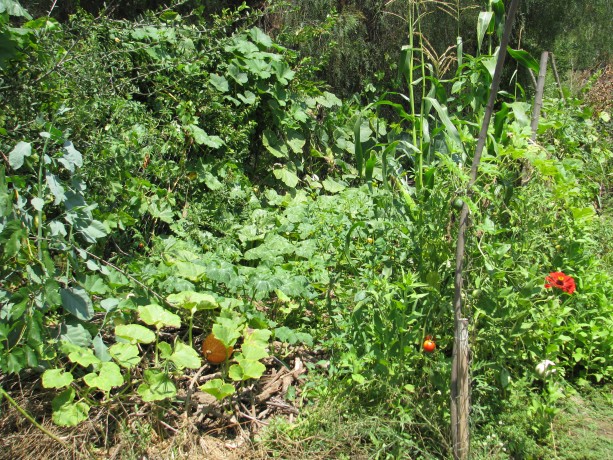
Squash, melons, tomatoes, flowers, tomatillos, sweet potatoes and more flourish along a chain link fence and on a wire-and-post trellis we set up over buried wood. Vertical space is perfect for vines; the vines provide shade and protection for other plants, and mulch plus a harvest when they die down. They are exciting and fun to watch grow as well. I’ve wanted to show you more of the garden, using video as well as photos. The summer garden is beautiful and full of life. Life in the ground, in the water, in the air and on every plant. Last year the pond had an overgrowth of pond weed and algae. Since our pond is natural – meaning that it has no liner, just compressed clay, and is cleaned only by plants and fish with no other aeration or filtration – the idea of adding algaecide is unthinkable. In great pond water there are as many if not more microbes as in good soil. Algaecide may advertise that it doesn’t harm fish or frogs, but it will kill the small pond life that is keeping your pond and its animals healthy. Seven small koi were added (rescued from a golf course pond where they had been dumped) in the hopes that they would eat the emergent pond weed as it grew out of dormancy. We hadn’t seen the koi and thought that they were dead. A couple of months ago they were sighted: all seven, each about a foot long and magnificent. We have no pond weed nor algae overgrowth thanks to these beauties.
In the following short video you’ll see some of the koi and possibly some of the bluegill and mosquito fish that also inhabit the pond. Notice a small blue dragonfly alighting on the bamboo pole. Birds call out all around. You’ll also hear my work shoes squeaking! The size and vigor of the water lilies is due to the healthy, microbially balanced water. We keep the pond topped up from the well. Well water here in San Diego County is notoriously salty and mineral-laden. Plants and microbes remediate that water, as is obvious in this video. The last part is of the native marsh fleabane which was sown by wild birds and flourishes around the pond. The small groups of flowers are perfect for our tiny native insects to land upon and feed. A honeybee uses it here. Enjoy with me a moment by the pond; the following link will send you to a Youtube video:
- Animals, Bees, Birding, Building and Landscaping, Chickens, Cob, Compost, Composting toilet, Fungus and Mushrooms, Gardening adventures, Giving, Health, Heirloom Plants, Hiking, Houses, Hugelkultur, Humor, Living structures, Natives, Natural cleaners, Other Insects, Permaculture and Edible Forest Gardening Adventures, Pets, Photos, Predators, Quail, Rain Catching, Recycling and Repurposing, Reptiles and Amphibians, Seeds, Soil, Vegetables, Water Saving, Worms
Special Tours for Aug. and Sept., 2014
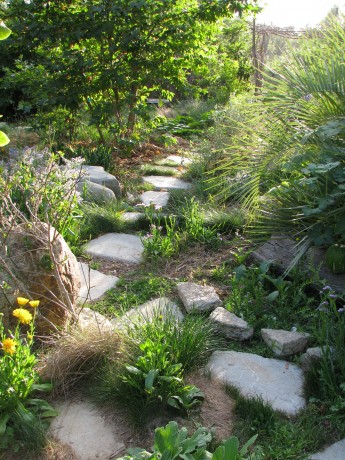
Come take a tour of a food forest! Normally tours of Finch Frolic Garden are held by appointment for groups of 5 – 15 people, Thursdays – Mondays. Cost is $10 per person and the tour lasts about two hours. By popular demand, for those who don’t have a group of five or more, we will be hosting Open Tour days for the first 15 people to sign up in August and September. They will be Sunday, August 10 and 24, Sept. 7 and 21, and Thursdays August 7 and 28, and Sept. 11 and 25. Tours begin promptly at 10 am. The tours last about two hours and are classes on basic permaculture while we tour the food forest. I ask $10 per person. Please reserve and receive directions through dianeckennedy@prodigy.net. Children under 10 are free; please, no pets. Photos but no video are allowed. Thank you for coming to visit! Diane and Miranda
- Animals, Bees, Birding, Books, Building and Landscaping, Chickens, Cob, Compost, Composting toilet, Fungus and Mushrooms, Gardening adventures, Heirloom Plants, Hugelkultur, Humor, Living structures, Natives, Natural cleaners, Other Insects, Permaculture and Edible Forest Gardening Adventures, Ponds, Predators, Quail, Rain Catching, Recycling and Repurposing, Reptiles and Amphibians, Seeds, Soil, Water Saving, Worms
Permaculture Lectures At Finch Frolic Garden, June 2014
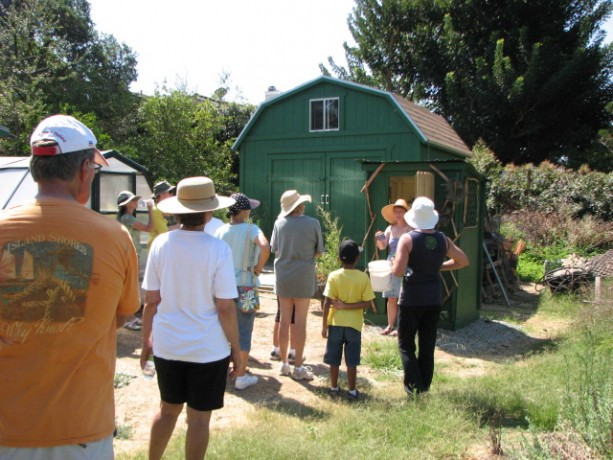
Tour Finch Frolic Garden! Permaculture Lectures in the Garden!
Learn how to work with nature and save money too
Finch Frolic Garden and Hatch Aquatics will present four fantastic, information-filled lectures in June. Join us at beautiful Finch Frolic Garden in Fallbrook, 4 pm to 6 pm, for refreshments and talks on…
Saturday, June 7: Introduction to Permaculture and Finch Frolic Tour: We’ll take you through the main precepts of permaculture and how it can be applied not only to your garden, but to yourself and your community. Then we’ll tour Finch Frolic Garden and show rain catchments, swales, plant guilds, polyculture, living buildings and so much more.
Saturday, June 14: Your Workers in the Soil and Earthworks: Learn the best methods for storing water in the soil and how to replace all your chemicals with actively aerated compost tea and compost.
Saturday, June 21: Aquaculture: You can have a natural pond – even in a tub! How natural ponds work, which plants clean water and which are good to eat. Even if you don’t want a pond, you’ll learn exciting information about bioremediation and riparian habitat.
Saturday, June 28: Wildlife in your Garden: What are all those bugs and critters and what they are doing in your yard? We’ll discuss how to live with wildlife and the best ways to attract beneficial species.
Your hosts and lecturers will be
Jacob Hatch Owner of Hatch Aquatics. With years of installing and maintaining natural ponds and waterways, and a Permaculture Design Course graduate, Jacob has installed earthworks with some of the biggest names in permaculture.
Miranda Kennedy OSU graduate of Wildlife Conservation and wildlife consultant, Miranda photographs and identifies flora and fauna and maps their roles in backyard ecosystems.
Diane Kennedy Owner of Finch Frolic Garden, lecturer, consultant, Permaculture Design Course graduate, former SDC Senior Park Ranger, Diane educates homeowners on how to save money and the environment while building their dream gardens.
Each class limit is 50 attendees, so please make pre-paid reservations soon before they fill up. Fee for set of four lectures and tour is $45 per person. Single session fee is $20 per person. Contact Diane Kennedy at dianeckennedy@prodigy.net for reservations and directions.
You will not want to miss this fascinating and useful information!

